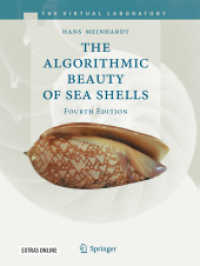- ホーム
- > 洋書
- > 英文書
- > History / World
Full Description
A fascinating and approachable deep dive into the colonial roots of the global wine industry.
Imperial Wine is a bold, rigorous history of Britain's surprising role in creating the wine industries of Australia, South Africa, and New Zealand. Here, historian Jennifer Regan-Lefebvre bridges the genres of global commodity history and imperial history, presenting provocative new research in an accessible narrative. This is the first book to argue that today's global wine industry exists as a result of settler colonialism and that imperialism was central, not incidental, to viticulture in the British colonies.
Wineries were established almost immediately after the colonization of South Africa, Australia, and New Zealand as part of a civilizing mission: tidy vines, heavy with fruit, were symbolic of Britain's subordination of foreign lands. Economically and culturally, nineteenth-century settler winemakers saw the British market as paramount. However, British drinkers were apathetic towards what they pejoratively called "colonial wine." The tables only began to turn after the First World War, when colonial wines were marketed as cheap and patriotic and started to find their niche among middle- and working-class British drinkers. This trend, combined with social and cultural shifts after the Second World War, laid the foundation for the New World revolution in the 1980s, making Britain into a confirmed country of wine-drinkers and a massive market for New World wines. These New World producers may have only received critical acclaim in the late twentieth century, but Imperial Wine shows that they had spent centuries wooing, and indeed manufacturing, a British market for inexpensive colonial wines. This book is sure to satisfy any curious reader who savors the complex stories behind this commodity chain.
Contents
Contents
List of Illustrations
Acknowledgments
Introduction
PART ONE. ORIGINS, C. 1650-1830
1 • Writing about Wine
2 • Why Britain?
3 • Dutch Courage: The First Wine at the Cape
4 • First Fleet, First Flight: Creating Australian Vineyards
5 • Astonished to See the Fruit: New Zealand's First Grapes
PART TWO. GROWTH, C. 1830-1910
6 • Cheap and Wholesome: Cape Producers and British Tariffs
7 • Echunga Hock: Colonial Wines of the Nineteenth Century
8 • Have You Any Colonial Wine? Australian Producers and British Tariffs
9 • Planting and Pruning: Working the Colonial Vineyard
10 • Sulphur! Sulphur!! Sulphur!!! Phylloxera and Other Pests
11 • Served Chilled: British Consumers in the Victorian Era
12 • From Melbourne to Madras: Wine in India, Cyprus, Malta, and Canada
PART THREE. MARKET, C. 1910-1950
13 • Plonk! Colonial Wine and the First World War
14 • Fortification: The Dominions and the Interwar Period
15 • Crude Potions: The British Market for Empire Wines
16 • Doodle Bugs Destroyed Our Cellar: Wine in the Second World War
PART FOUR. CONQUEST, C. 1950-2020
17 • And a Glass of Wine: Colonial Wines in the Postwar Society
18 • Good Fighting Wine: Colonial Wines Battle Back
19 • All Bar One: The New World Conquers the British Market
Conclusion
Appendix: Notes about Measurements
Notes
Bibliography
Index








